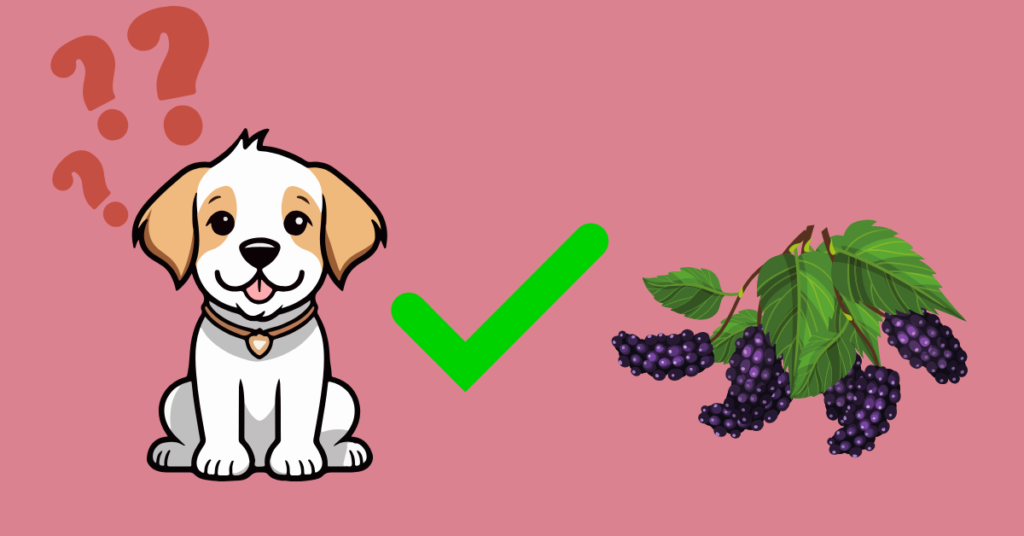Mulberries are a delicious and nutritious fruit packed with vitamins and antioxidants. They’re a summertime treat many enjoy, but can dogs eat mulberries?
The good news is, yes, mulberries are safe for dogs in moderation.
Below we’ll explore the specifics of feeding mulberries to your dog, including the potential benefits and how much is too much.
Can Dogs Eat Mulberries?
Yes, mulberries are safe for dogs to eat in moderation. They’re a good source of vitamins and antioxidants, like most berries. However, there are some things you need to keep in mind when feeding your dog mulberries.
When it comes to mulberries, it’s all about the ripeness. Unripe mulberries aren’t exactly dangerous, but they can cause some tummy troubles. In rare cases, they might even lead to some unexpected doggy hallucinations!
But don’t worry, telling the difference between ripe and unripe mulberries is as easy as spotting a green light from a red one. Ripe mulberries are deep red or black, while unripe ones are green.
If you do decide to feed your dog mulberries, use these 3 guidelines:
- Wash the mulberries before feeding them to your dog. You want to remove any dirt, pesticides, or other contaminants.
- Start with a small amount. As with any food, start with only a small amount. Many dogs are sensitive to new foods and may get an upset stomach from eating too much.
- Pick the berries: If you are outside next to wild mulberry trees, it’s best to pick the fully ripe berries from the top of the trees and not give your dog any fallen berries. This is to avoid giving your dog berries that may have been contaminated.
You may be wondering, ‘Can dogs eat mulberry leaves?’ The answer is no. Only the berries from the mulberry tree are safe to eat. The other parts of the tree contain a toxic white sap.

What Are the Risks of Dogs Eating Mulberries?
There aren’t many risks of eating mulberries, especially when consumed in moderation. However, there are a few things you should look out for:
- Unripe mulberries: As we’ve discussed, unripe mulberries are not safe for dogs to eat.
- Pesticides: If you feed your dog commercially grown mulberries, pesticide exposure is possible.
- Allergic reaction: Though allergies to mulberries are rare in dogs, it could still happen. If you notice your dog itching, sneezing or licking their paws after eating mulberries, stop feeding them to your pup.
- Digestive issues: Many dogs are sensitive to new foods, and mulberries are no different. Diarrhea and vomiting can occur if your dog consumes too many mulberries. Start with a small amount of mulberries and increase as your dog tolerates it.
- Sugar content: Ripe mulberries do contain quite a bit of sugar. Too much sugar can lead to weight gain and other health problems. Just like we shouldn’t overeat fruit, our dogs shouldn’t, either.
Luckily, mulberries in moderation do have several potential health benefits.
What Are the Health Benefits of Mulberries?
Mulberries have the potential to be like tiny superheroes for your dog’s immune system. They’re packed with antioxidants and nutrients, making them great for humans and dogs. Here are some of the main benefits:
- Blast of antioxidants: Antioxidants fight oxidation, which is associated with many health problems. Simply put, they fight free radicals, protecting the organs. Resveratrol is one of the antioxidants in mulberries, and it has been shown to improve dog’s immune systems.
- Digestion defense: Mulberries contain a lot of fiber, just like most berries. Fiber is a prebiotic, meaning it feeds the microorganisms in your dog’s gut. This fiber also causes stomach upset if your dog eats too much, though.
- Building healthy bones: Mulberries might not seem like it, but they’re packed with calcium and vitamin K, making them great for building strong bones. They may even help with healing after a broken bone.
- Blood production: Mulberries also (surprisingly) contain a lot of iron. While this is usually found in meat, it’s also found in many berries, like mulberries. Iron is used to create red blood cells, and an iron deficiency can cause anemia.
Though mulberries are packed with nutrition, you likely won’t notice your dog experiencing any health boost after eating mulberries. The amount they will be receiving is so small they won’t see any difference.
Offering your pup a few juicy berries can be a wonderful enrichment activity for them.
How Many Mulberries Can Dogs Eat?
The amount of fresh mulberries your dog can safely eat depends on their size. Here’s a general guideline:
- Tiny Terriers: If your dog is under 10 pounds, stick to just a few berries (think 3-5) at most. Cut larger ones into small pieces.
- Mid-Sized Mutts: For medium dogs between 10 to 25 pounds, a small handful of 10-15 berries should be okay! Just remember to start with fewer and slowly work your way up.
- Big Barkers: Larger dogs over 25 pounds can handle a bigger serving. However, we recommend keeping the max at around 20 berries or a quarter cup.
Of course, you can adjust these amounts to meet your dog’s needs. Some dogs are more sensitive than others, so they may need fewer mulberries than the guidelines above.
As always, dogs should only receive about 10% of their daily calorie allowance in the form of treats.
FAQs
Can dogs have black mulberries?
Yes, dogs can have black and red mulberries. These colors of mulberries show the berry is ripe and safe for dogs to eat.
What berries are toxic to dogs?
Several types of berries can be toxic to dogs, including grapes and raisins, which can cause kidney failure. Holly berries can lead to severe gastrointestinal issues such as vomiting and diarrhea, while juniper berries may cause kidney problems and digestive issues.




